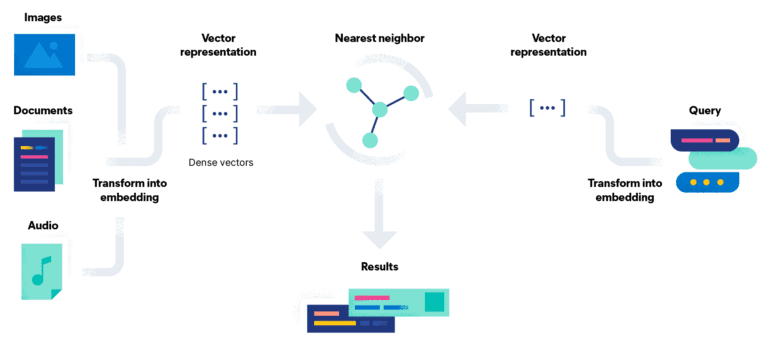TL;DR:
- Elastic introduces Elasticsearch Relevance Engine (ESRE), integrating AI and vector search for enhanced search relevance and generative AI support.
- ESRE expands Elasticsearch’s vector support, integrating transformer neural network models for improved semantic search results.
- Enterprises can bring their own transformer models, like OpenAI’s GPT-4, to leverage generative AI within Elasticsearch.
- ESRE combines search relevance technologies into a cohesive offering, revolutionizing enterprise search capabilities.
- Elasticsearch now offers a dual approach with BM25f and vector-based search, delivering more accurate and precise results.
- Elastic’s late encoding model enhances text-based queries, enabling precise semantic retrieval of untrained data.
- ESRE opens up Elasticsearch for integration with external AI models, allowing organizations to gain insights from their data.
Main AI News:
Elastic, a leading provider of enterprise search solutions, has unveiled the Elasticsearch Relevance Engine (ESRE), a groundbreaking integration of artificial intelligence (AI) and vector search. This cutting-edge technology enhances search relevance and empowers generative AI initiatives, revolutionizing the way organizations leverage their data.
For over a decade, Elastic has been at the forefront of developing its enterprise Elasticsearch technology, leveraging the robust capabilities of the open-source Apache Lucene data indexing and search project. In February 2022, Elastic introduced vector embedding support, effectively transforming Elasticsearch into a vector database—a critical asset in the realm of AI.
Now, with the introduction of ESRE, Elasticsearch takes a giant leap forward by expanding its vector support. To further enhance search accuracy, Elastic has seamlessly integrated its own transformer neural network model into ESRE, enabling superior semantic search results.
ESRE doesn’t stop there—it also enables enterprises to incorporate their own transformer models, including the highly acclaimed OpenAI’s GPT-4, to unlock the immense potential of generative AI within Elasticsearch. This groundbreaking advancement empowers organizations to elevate their Elasticsearch content by harnessing the power of state-of-the-art AI models.
“ESRE is the culmination of our efforts to consolidate various search relevance technologies into a unified offering,” stated Matt Riley, General Manager of Enterprise Search at Elastic. By seamlessly merging search relevance, vector search, and generative AI capabilities, Elastic empowers enterprises to extract invaluable insights from their vast repositories of data.
Transforming the Landscape of Search with Elasticsearch
For the past decade, Elasticsearch has relied on the BM25f best match algorithm to rank and score documents, delivering relevant search results. Now, with the integration of vector search through ESRE, Elasticsearch offers a dual approach, combining the power of BM25f with vector-based search. With vector-based search, content is assigned numerical representations, and relevance is determined by proximity between numbers using techniques like approximate nearest neighbor (ANN).
“Our primary objective at Elastic is to provide our customers with the most effective means of retrieving relevant documents from their extensive Elasticsearch data,” explained Riley. Whether through vector search, text-based BM25f search, or a fusion of the two, Elastic remains committed to delivering unparalleled search accuracy and precision.
While vector search significantly enhances relevance, Elasticsearch understands that text-based queries require more advanced techniques for optimal results. To address this, Elastic has developed a groundbreaking late encoding model—a variant of sparse encoding—capable of comprehending text to extract highly precise search results.
“Leveraging late interaction models enables us to achieve semantic retrieval on a text that the model was not explicitly trained on,” highlighted Riley. With this innovation, Elasticsearch empowers enterprises to delve deeper into their data and uncover hidden insights with exceptional precision.
Bring Your Own (Transformer) Model to Elasticsearch
ESRE marks an important milestone for Elastic as it embraces the power of collaboration and customization. Elastic has extended Elasticsearch’s capabilities to support the integration of external AI models, allowing organizations to unlock new dimensions of knowledge from their data.
As part of ESRE, Elastic has partnered with OpenAI, integrating the GPT-4 LLM (Language Model) into Elasticsearch. This integration empowers organizations to harness the immense potential of generative AI, enabling them to summarize text, perform sentiment analysis, and even answer complex questions. Additionally, organizations can leverage open-source LLMs available on Hugging Face, further expanding the range of possibilities for insight extraction.
Riley emphasized the significance of this collaboration, emphasizing the bridge it creates between Elasticsearch’s data and LLMs, which may not have been previously trained on private data. “The ongoing transformation of these transformer models holds incredible promise,” Riley added. “With these new capabilities, we can expect a surge in groundbreaking applications.”
ESRE: Revolutionizing Enterprise Search with AI
Elastic’s Elasticsearch Relevance Engine represents a significant leap forward in the world of enterprise search. By seamlessly integrating AI and vector search, Elastic has redefined search relevance and unleashed the power of generative AI. With ESRE, enterprises can now tap into the full potential of their data, harnessing the capabilities of transformer models and elevating their Elasticsearch content to new heights.
Conclusion:
The introduction of Elasticsearch Relevance Engine (ESRE) represents a major advancement in enterprise search. By integrating AI and vector search, Elastic provides improved search relevance and supports generative AI initiatives. Enterprises can leverage transformer models, like OpenAI’s GPT-4, to unlock the power of generative AI within Elasticsearch. This development consolidates various search relevance technologies into a unified offering, transforming the market by enabling more accurate and precise search capabilities.
The integration of vector-based search and Elastic’s late encoding model further enhances the retrieval of relevant information from textual queries. Additionally, ESRE’s ability to integrate external AI models opens up new possibilities for organizations to extract valuable insights from their data, propelling the market forward in leveraging AI-driven search technologies.

